Contemporary Grammars
Digital Textures As An Existential Compass
Several short films in Short Waves Festival’s 2023 international competition question the reactive relationship to our known visual referents that tend to be the norm with digital models and propose a more perceptual use of them, emotive even.
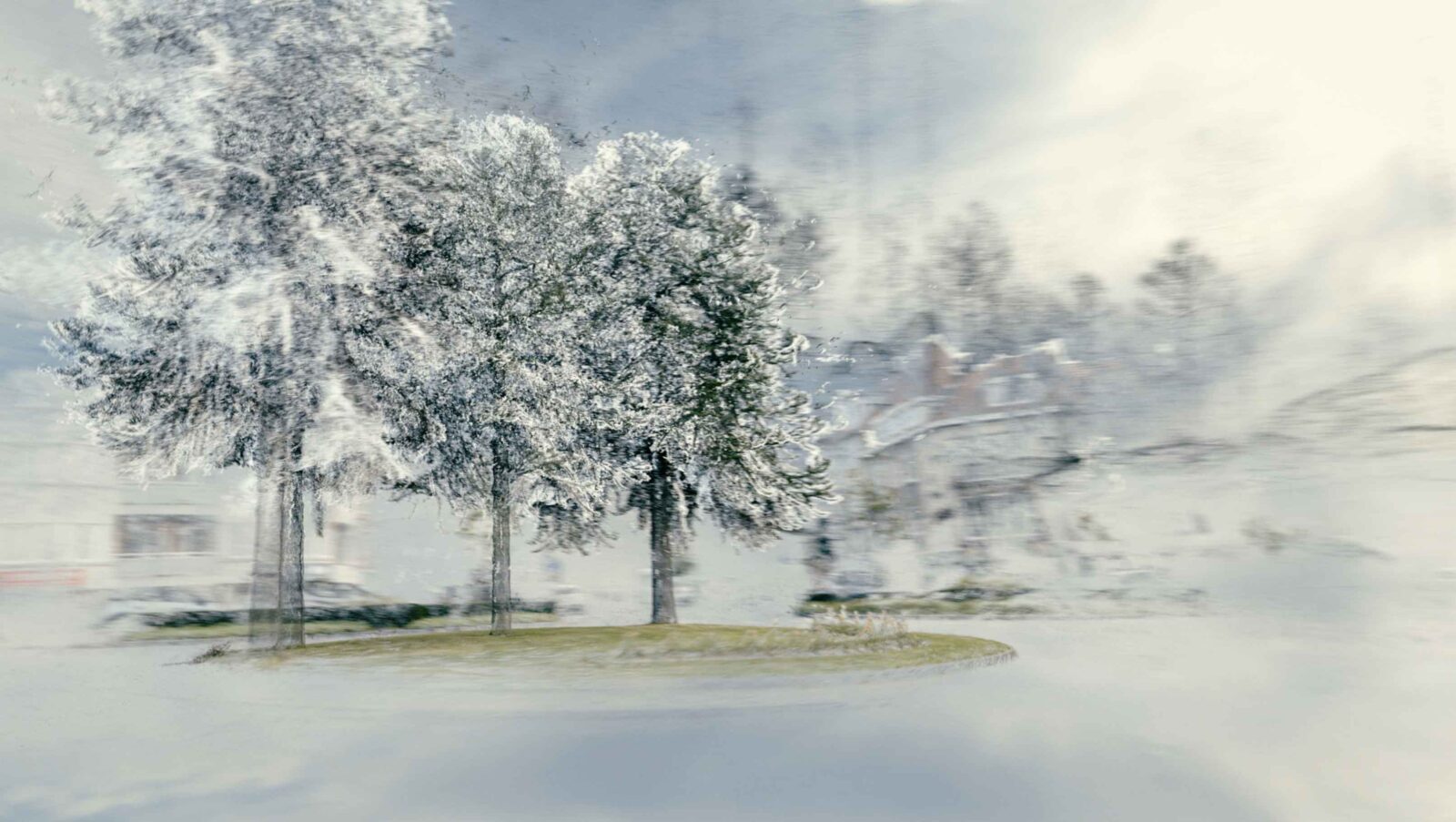
The aseptic white hues radiating from our computer and smartphone screens resemble a portal. Layers, icons, textures: the whole landscape transforms as we immerse ourselves in the digital realm. However, the flow of everything is too amorphous to really call it a world, at least not one fully palpable to us. There’s no actual geography or ambiance. The visual referents that ground us depend on what apps we use or what corners of the internet we frequent. The way we communicate varies from abbreviations of our language to the merely pictorial in emojis and gif reactions, to pure motion in how we move the cursor and flicker through different windows.
Our limbs work mindlessly and mechanically as we click and scroll. Every aspect of our everyday life is deconstructed and then reorganised through the filter of hyperconnectivity. Elliptic jump-cuts between display screens violently take us from one context to another. Without the motive that frames our experience (leisure, labor, love, lust, etc.), the chaotic current of “being online” feels like an endless stream of pop culture, official history, and marginalia overspilling with no rhyme or reason.
We aim for comfort and familiarity and crave seeing our reflection on the screen. We conceive digital avatars just to get a sense of something bearing our identity, of feeling like we can inhabit this unwelcoming conglomerate. But something’s always off—a pixel, the shading, the motions. We exist as compartmentalised versions of ourselves, built from generalised referents of what the algorithm considers our essence. There’s an inherent fragmentation that makes it feel simultaneously solipsistic and homogenous. It’s an unnerving stroll through the uncanny valley, and it doesn’t need to be that way.
Once submerged in the walls of flickering lights that are our screens, the nuances that set apart the organic realm are blurred. The all-encompassing mantle of standardisation detaches cultural expressions from their place of origin or context and leaves them adrift amidst the endless seas of content. South Korean cultural theorist Byung-Chul Han calls these processes of fluidity, constant change, and lack of epistemic particularity “Hyperculture”, a concept that expands on American sociologist Ted Nelson’s take on the “hypertext”, an interlinked network of texts lacking any center, simply looped together endlessly even in growth, and integrates it into the way a monolithic culture comes as a byproduct of the digital existence. In our Hyperculture, everything becomes malleable, which means there’s also the potential for discovery and exploration; it’s just a matter of rearranging and reconnecting.
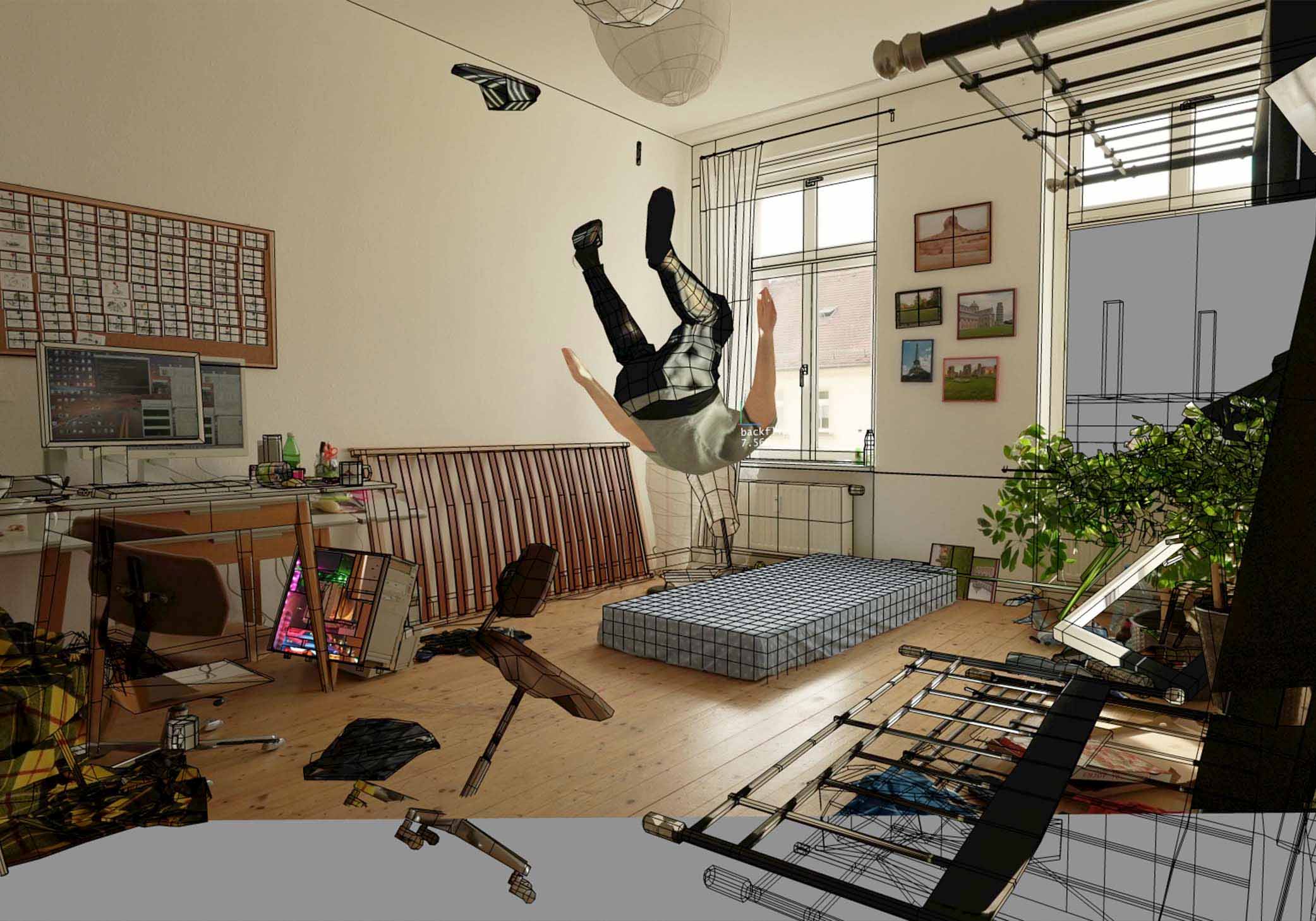
backflip
That seems to be the thesis behind Nikita Diakur’s backflip, whose title is bereft of any symbolic or allegorical intent. We’re about to see a backflip. But not merely the result of the pirouette known as the backflip; we’re experiencing the trial and error process that goes behind the construction of the backflip. Instead of the heroics and spontaneity that one might expect from such an impressive aerobic feat, what interests Diakur is the aggregate procedure itself.
An AI voice guides us through the process, clinically dissecting the trial-and-error sequencing of a 3D avatar trying to land on its feet. As the glitched loop of clunky acrobatics unfolds on screen, the lifeless narration keeps it monotone. “Attempting a backflip is not safe. You can break your neck, or land on your head, or land badly on your wrist,” says the voice, exerting a value judgment constructed through the factual scanning of possibilities. “None of that is nice, so my avatar does the trick. It practices on a 6-core processor with the help of Machine Learning. The processor is not the newest but still calculates six jumps per iteration. One iteration takes one minute; this is 360 jumps in an hour and 8.640 jumps in a day. I wouldn’t be able to jump so much myself,” the voice shatters the veil of illusion in a Brechtian exercise of pure mathematical automation. And yet, we can’t help but project onto the algorithmic display.
Like in our cultural consumption, we seek humanity in compiled data. We personalise it so we can relate; it’s essentially constructing an avatar all over again. This avatar, however, isn’t built on our notions of physical resemblance. It isn’t visible per se, as it instead looks to channel our viewership as conceived through the same ground rules of what we’re witnessing. The PlayStation 2-esque model trying to accomplish the coveted backflip that ragdolls all over the screen in its Odyssean quest to defy its limited graphical physics, and for some reason, we start genuinely rooting for it. The relationship with the “body” on-screen starts as pure slapstick; we marvel as it clumsily fumbles around, but soon enough, the repetition makes it genuinely endearing. The futility of the task at hand is at the forefront of the exercise, so it creates a relatable arc almost by accident. Seeing that poor digital model accomplish something impossible becomes nearly aspirational for the viewer, we reclaim the algorithmic and frame it through humanity. No matter how distant and abstracted the veneer of digitality is in the film’s whole presentation, from texture to narration, the semblance of recognition is enough to make us wonder.
Using the digital sphereto artificially construct recognition is at the heart of Julián García Long’s The Despair of Monkeys (La desesperación de los monos). The film studies the ephemeral nature of representation through the evolution of araucaría trees’ cinematic depictions. To do so, García Long uses footage of a Patagonia region in Argentina from a moment when its iconography doesn’t match contemporary referents. The main symbol of displacement found in these archival images is the presence of the aforementioned trees, which the voice-over explains were an endemic species progressively replaced by the utilitarian need for “more productive trees”.
The adriftness at the heart of The Despair of Monkeys goes beyond antiquated and nullified representations of a location and instead engages with a more asynchronous route, where globalisation and hyperculturality erase the traces of identity that tend to build affection, the textures, the subtle details on the background, and all those little quirks that conform a setting’s sense of place. The araucaría trees were once an almost primal presence in the expansive South American plains, carriers of the uncharted aura that is constantly used to mystify the region, but are now reduced to the mere ornamental, bourgeois signifiers of class used to exalt a very nebulous idea of “the exotic” in rich Central European nations like Belgium, where García Long is based. Naturally for the filmmaker, witnessing the trees of his native soil as adornments of nondescript upscale neighbourhoods, merely in the background and occasionally referenced by curious European kids, feels like a banalisation. There’s also a personal projection, as the scars left by García Long’s migration from Patagonia burn once again. The banner of “the digital sphere” was to deem geographies meaningless. Nevertheless, their tangible spatiality is integral to forging identities.
To confront the violent implications of the neocolonial landscape, García Long fiscalises the same images he uses. Through the juxtaposition of spectral frames from a vanished reality and the eerie data constructs from technoscientific labs, the film embodies the possibility of imagining new spaces through the seemingly endless potential for transformation inherent to the digital experience. After all, the “documentary register” that guides archival footage only has the veneer of objectivity as long as it’s contextualised via its historiographic limitations. What documentary film captures is a deliberate frame within a determined moment in time. This temporal and spatial specificity is what passes as “reality”, but it’s no less abstract than the glitched polygonal modeling of the ethereal araucarias.
As with the uncanny in backflip, there’s an important discomfort from seeing the lab-created trees. They’re a cartoon version of something, recognisable insofar as one with the original referent in mind, but they don’t feel natural. However, as with our increased dose of online time, our senses are recomposed, no longer caring for verisimilitude in depictions. What’s more important is the latter’s aura. How they fit within the horizon and the shadows they inscribe in the landscape. All those details make a lasting impression that transcends how photorealistic the visual representation is. There lies the aesthetic virtue of The Despair of Monkeys. It devoids the viewing experience of the usual hierarchy in the models of registering, which tends to position a rational relationship with images before it starts using them as tools for affection. García Long’s film does the opposite, as the register is constructed in real-time through an amorphous affection, the nostalgia for a place that no longer looks how one recalls. That is what informs the way we approach those polygonal araucaría trees. Why are things artificial when the feelings they generate are tangible? The digital is not only a tool for reconstruction and retracing but also for imagining new types of spaces, transcending the mathematical, and embracing the unassuming warmness that lies behind cold pixels.
The process of digital assimilation can also be two-fold, however. As it molds our ways of understanding, it’s permeated by an unfiltered version of our contemporary preoccupations. We have fully absorbed and repurposed the corporate templates into our new forms of expression. It’s scattered and at times post-semantic, just like the online experience, an abrasive flux of contents charged with colliding discourses. Even so, at the end of the day, this sensory expansion is still held together by a feeling of recognition. The reason the unnatural motions and inconsistent surfaces are immersive depends entirely on us seeing them as extensions of ourselves. We attach an emotional grammar to what our digital avatars experience. Aimless videogame walks through repetitive backgrounds and barren, seemingly infinite landscapes of dead space are already integrated into how we communicate, into how we feel when we’re in this symbiotic relationship with the digital. In many ways, it’s the truest embodiment of our current societal mind state, since it’s fully our design.
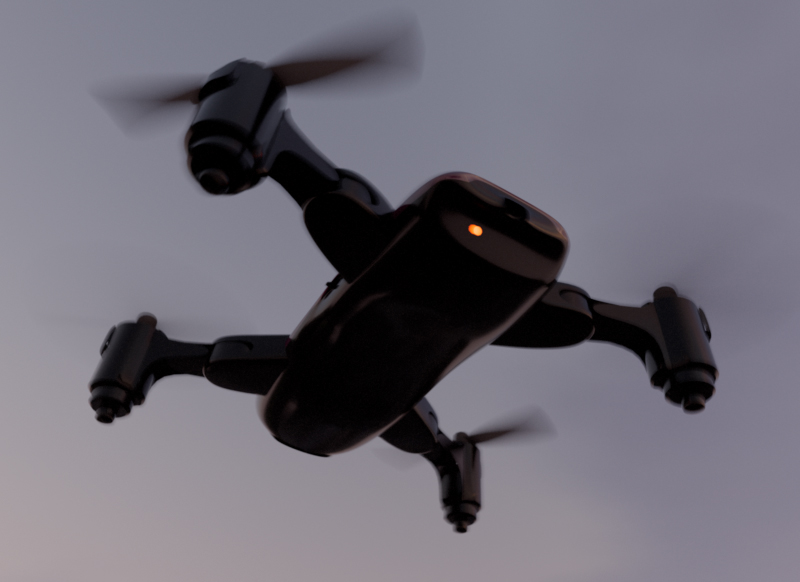
Cyclepaths
Anton Cla’s Cyclepaths presents a digital city symphony of sorts, aggregating bizarre routines and detached urban spaces until a sensory rhythm builds organically. The film directly plays with the idea of a digital grammar permeated by and experienced through an anthropocentric perspective, articulating the most modern of sentiments: alienation. To do so, the film establishes a very rough overview of its space and ecosystem. We see an old woman carrying shopping bags with a drained grimace. A child is nonchalantly riding a scooter with a gun in his hand. There’s a veneer of absurdism in the mundanity of the set-up, but at the same time, its atmosphere of utmost detachment feels vivid. It’s as transparent a projection of the aseptic flow of the contemporary world as it can get, without almost no need for hyperbole at all.
Cyclepaths has no clear cartographical intent in representing its nameless city. For all we know, it might just be composed of the couple of vignettes we’re shown, with a gray void of nothingness in between. It feels apocalyptic, yet distanced from the usual associations with that word. In the digital rapture, there’s no need for catastrophe or an external force exerting its power over humanity, be it natural, extraterrestrial, or spiritual. For all it’s worth, the end might come, and we might just sigh briefly before going extinct.
The city is already falling apart, after all. What would be the difference? How would the birds flying over the lifeless gray textures be even aware that “everything” is coming to an end? What is “everything”? There’s a party briefly shown in the city. Everybody in it seems unfased by the doom-laden air. It seems “lit”, but there are no signs of particular enthusiasm. There’s something to that. Perhaps we mistook the missiles for sound effects. Everything is clashing against itself, not in a particularly subtle way. Nevertheless, it shouldn’t be cause for concern; it’s not an anomaly, but simply how things are. Do we even remember when they weren’t like this? Are we even sure they haven’t always been like this? It hits so close to home that the idea of these stoic renderings being a projection of ourselves instead of the next evolutionary step becomes muddled.
The fixation on establishing a hard line between the digital and the organic seems anachronistic at this point in human history. What each of these films signals are different approximations of how these extensions of ourselves and our environment can be actively repurposed. They question the reactive relationship to our known visual and sensory referents that tend to be the norm with digital models and propose a more perceptual use of them, emotive even. The lack of perfection in depiction becomes an avenue for new meanings, and those are the ones that at least keep a glimmer of hope.
Both the technocratic embrace and the Luddite rejection kind of miss the mark in seeing that the only way any of this works is because there’s a dialogue. What came first and what informed what is irrelevant. It’s become cyclical by this point. All of this is just a matter of finding ways to navigate the uncertain stream we’re all currently on.
Mentioned Films
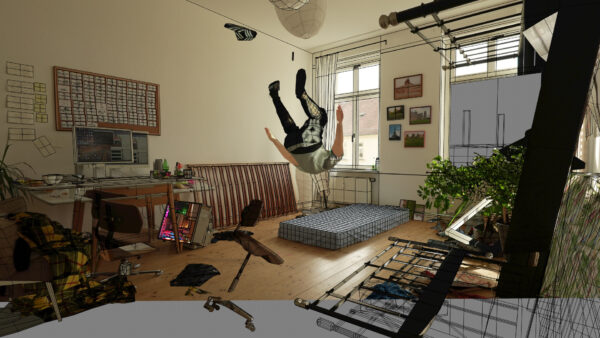
backflip
by
Nikita Diakur,
Germany,
2022,
12’
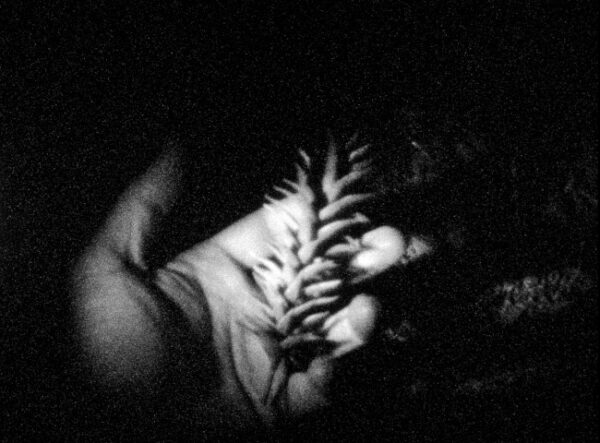
The Despair of Monkeys
by Julián Garía Long, France, 2023, 17’
A land that no longer resembles itself, the ancient Patagonian monkey puzzle trees are retreating before the invasion of pine forests. Across the ocean, in Brussels, the same trees adorn courtyards, streets and squares. A family driving in a car excitedly counts the araucarias. How did these trees become a symbol of Western European bourgeois fashion?
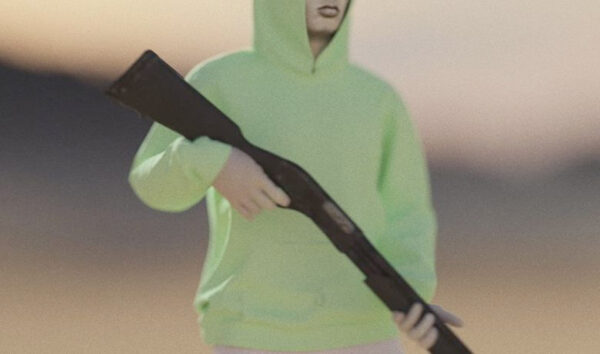
Cyclepaths
by Anton Cla, Belgium, 2023, 12’
A presentation of movements categorised according to their trajective and cyclical nature. A research on the technical and narrative possibilities of contemporary computer animation.
